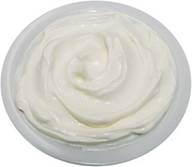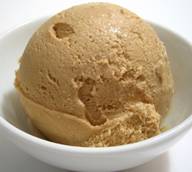SKIM MILK
Fat is removed by centrifugation in skimmed milk. Fat content is reduced to O.5-2%. By removing fat from the milk not only taste or flavour is reduced but fat soluble vitamins like vitamin A and Dare reduced. Usually this milk is fortified with vitamins A and D. Condensed skim milk finds extensive use in the baking industry and manufacture of confectionary. Skim milk is used for low calorie diets and for children who need high protein. |
 |
EVAPORATED MILK
This is the milk from which about 50-60% of the water has been evaporated. Raw milk is clarified and concentrated in a vacuum at a temperature of 74-77°C. It is fortified with vitamin D, homogenized, filled into cans sterilized in cans at a temperature of 118°C for 15 minutes and cooled. This heat treatment gives evaporated milk a light brown colour owing to sugar protein interaction and its characteristic flavour. |
 |
SWEETENED CONDENSED MILK
Sweetened condensed milk unlike evaporated milk is not sterile. Multiplication of micro-organisms in the product is prevented by the preservation action of sugar. The product is made from pasteurized milk that is concentrated and sweetened with sucrose. Sugar concentrate is 65%. This milk cannot be substitute for the ordinary fresh milk. |
 |
MILK POWDER*
Non fat dry milk powder is usually made from fresh pasteurized. Skim milk by removing about two-thirds of the water under vacuum and there spraying this concentrated milk into a chamber of hot filtered air. This process produces a fine powder of very low moisture content, about 3% instant non fat dry milk disperses readily in cold water. To make the instant product, regular non fat dry milk is remoistened with steam to induce agglomeration of small particles into larger, porous particles that are creamy white and free flowing |
|
STANDARDIZED MILK
In standardized milk, the fat content is maintained at 4.5% and S.N.F a: 8.5 percent. It is prepared from a mixture of buffalo milk and skim milk. |
|
TONED MILK
Toned milk is prepared by mixing milk reconstituted from skim milk powder with buffalo milk containing 7.0 per cent fat. The fat content of the toned milk should be not less than 3 percent and S.N.F. 8.5 percent. |
|
DOUBLE TONED MILK
This is prepared by admixture of cow's or buffalo milk or both with fresh skimmed milk or by admixture with skim milk reconstituted from skim milk powder or by partial removal or addition of milk fat to skim milk. It should be pasteurized and show negative phosphotase test. Its fat content should be less than 1.5 percent and S.N.F. not less than 9 percent. |
|
RECOMBINED MILK
Recombined milk is a homogenized product prepared from milk fat, non-fat milk solids and water. It should be pasteurized and show a negative phosphotase test. Its fat content should be less than 3 percent and S.N.F. 8.5 percent. |
|
STERILIZED MILK
Standardized cow's or buffalo milk is sterilized in bottles by heating continuously to a temperature of 115°C for 15 minutes to ensure destruction of all microorganism and preservation at room temperature for not less than 85 days from the date of manufacture. It shall be sold only in the container in which milk was sterilized. |
|
FILLED MILK
Filled milk is the homogenized product prepared from refined vegetable oil and non-fat milk solids and water. Its fat content should not be less than 3 percent and S.N.F. 8.5 percent. |
|
FLAVOURED MILK
Flavoured milk may contain chocolate, coffee or any other edible flavour, edible food colour and cane sugar. It is either pasteurized or sterilized. |
 |
CREAM
Milk fat concentrated into the fraction of the original milk is cream. It is generally separated from milk by centrifugation. Cream containing various amount of fat is made to meet different requirements. A mixture of milk and milk fat of 10-12% is called half-and-half. The high percentage of fat helps to give more stable foam. Cream used for butter making usually contains 25-40%. Cream is also used in baked products and as well as salad dressings. Cream is also pasteurized at 70-75°C for 30 minutes (18%) to kill the bacteria. The cream is then inoculated with the controlled culture of lactic acid bacteria to develop the desired acid taste in the finished product. |
 |
YOGHURT-ICE CREAM MILK SHAKE**
It is a combination of two products yogurt ice cream and milk shake. Whole milk, cream and cane sugar are mixed with skim milk powder. This contains 8.1 and 3.25% of high and low fat respectively. A mixture of stabilisers (sodium alginate, carrageenan and guargum) is added to this mix and heat treated at 90°C for 15 minutes and cooled. It is inoculated with 2% starter culture consisting of Streptococcus salivarius spp, thermophilus,Lactobacillus delbruekii spp bulgaricus, L. acidophilus and Bifidobacterium bifidum. After incubating at 37°C for 12 hours the mix is kept at 4°C overnight for ageing. .Selected flavours such as strawberry, orange, pineapple, chocolate, mango, 'anar' or dry fruits and their respective colours are added and the mix is frozen in ice cream freezer at 5°C to give 60% over run. It is stored at -10°C to -20°C until use.
Milk shake is prepared by diluting the yoghurt ice cream mix to get 20%, total solids and 2.4% fat. Appropriate flavours, which are different to that of yoghurt ice cream (chocolate, coffee, mango, orange) and respective colours are added and stored at 4°C until serving |
 |
ICE CREAM
It is a frozen dairy product consisting of whole milk, skim milk, cream, butter, condensed milk products or dried milk products. Milk fat and milk solids non-fat constitutes about 60% of the total solids of the ice cream.
Percentage Composition of Ice cream:
Milk fat |
12 |
Milk solids-not-fats |
11 |
Sugar |
15 |
Stabiliser |
0.2 |
Emulsifier |
0.2 |
Essence |
traces |
|
 |
. Technologies Available
* - Post Harvest Technology Centre, TNAU, Coimbatore.
** - Home Science College and Research Institute, TNAU, Madurai.

